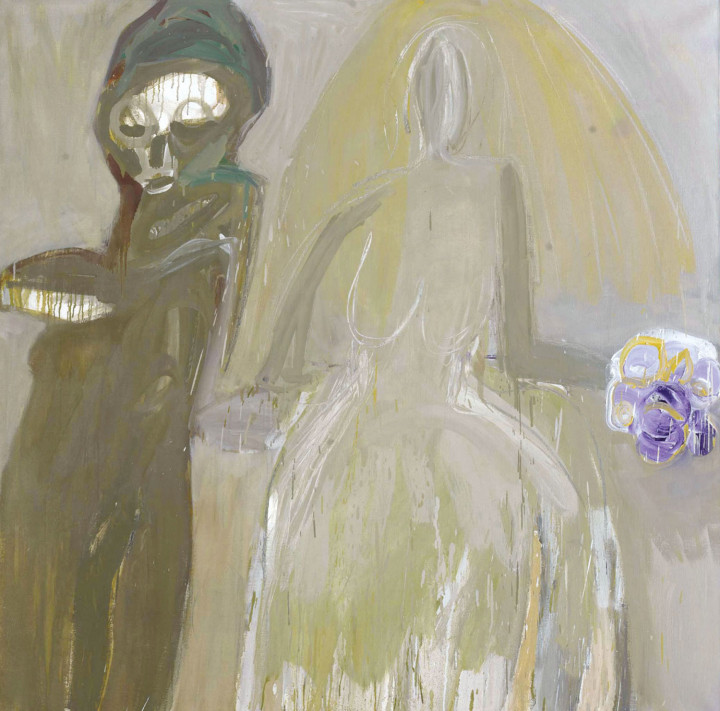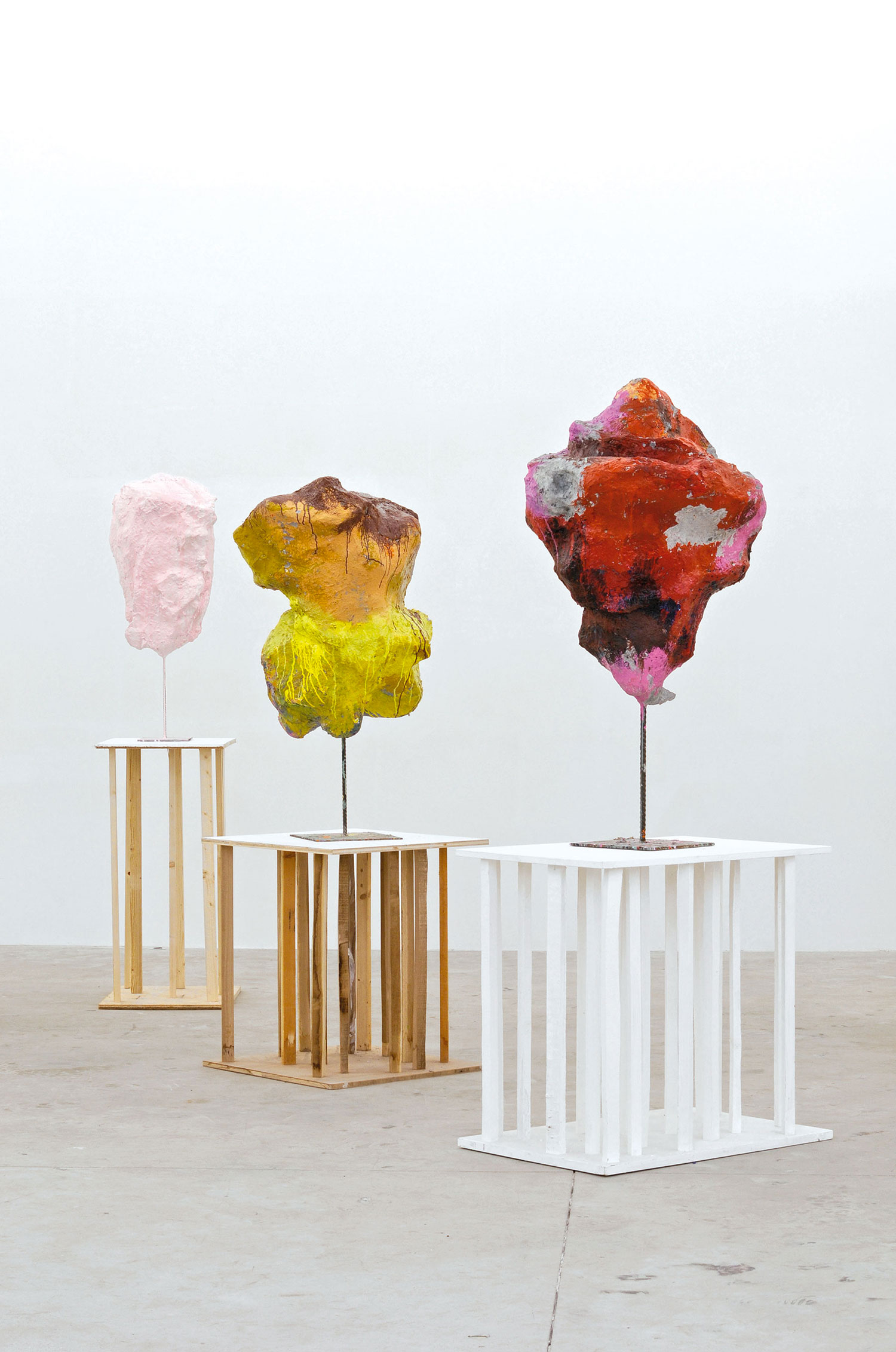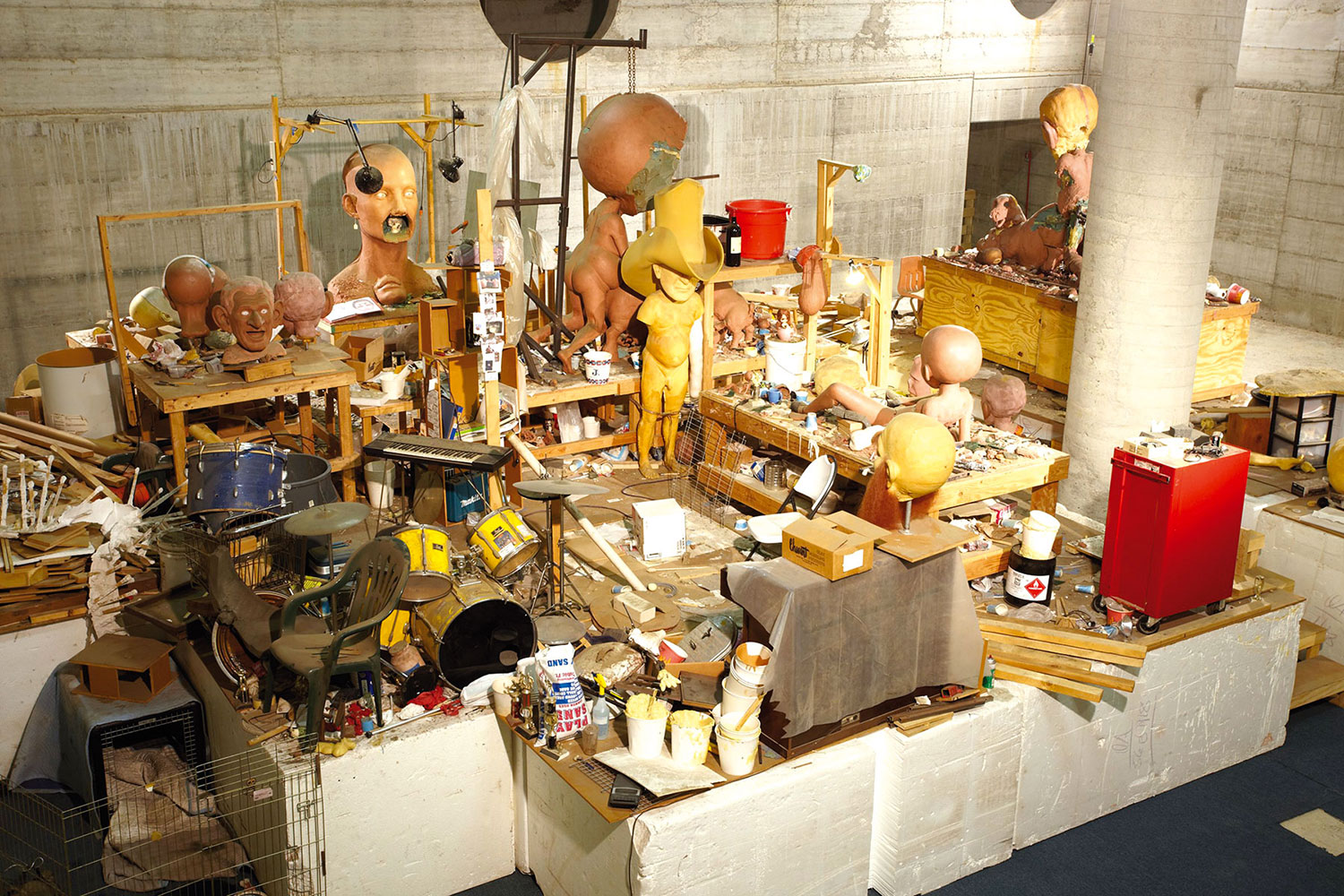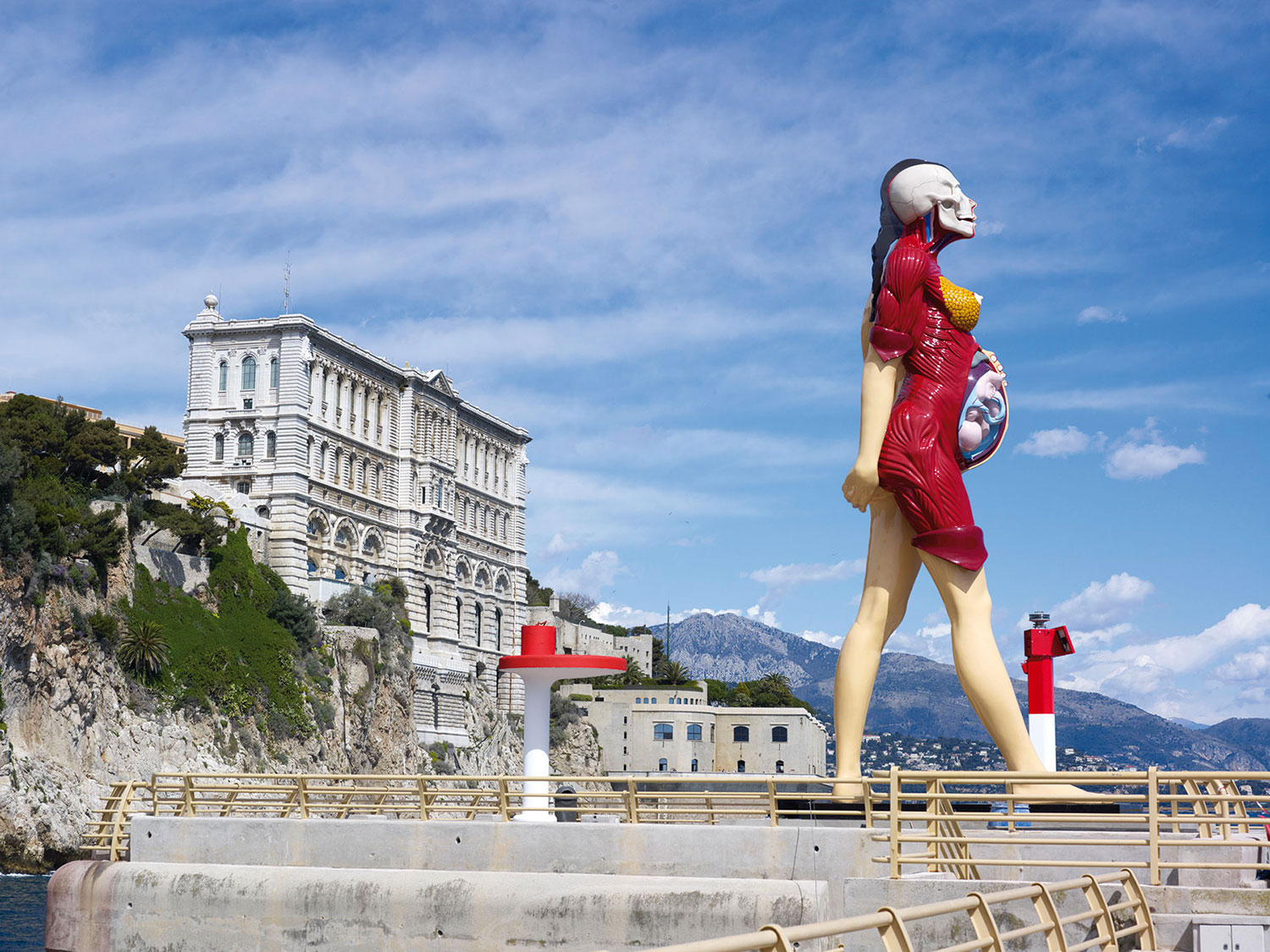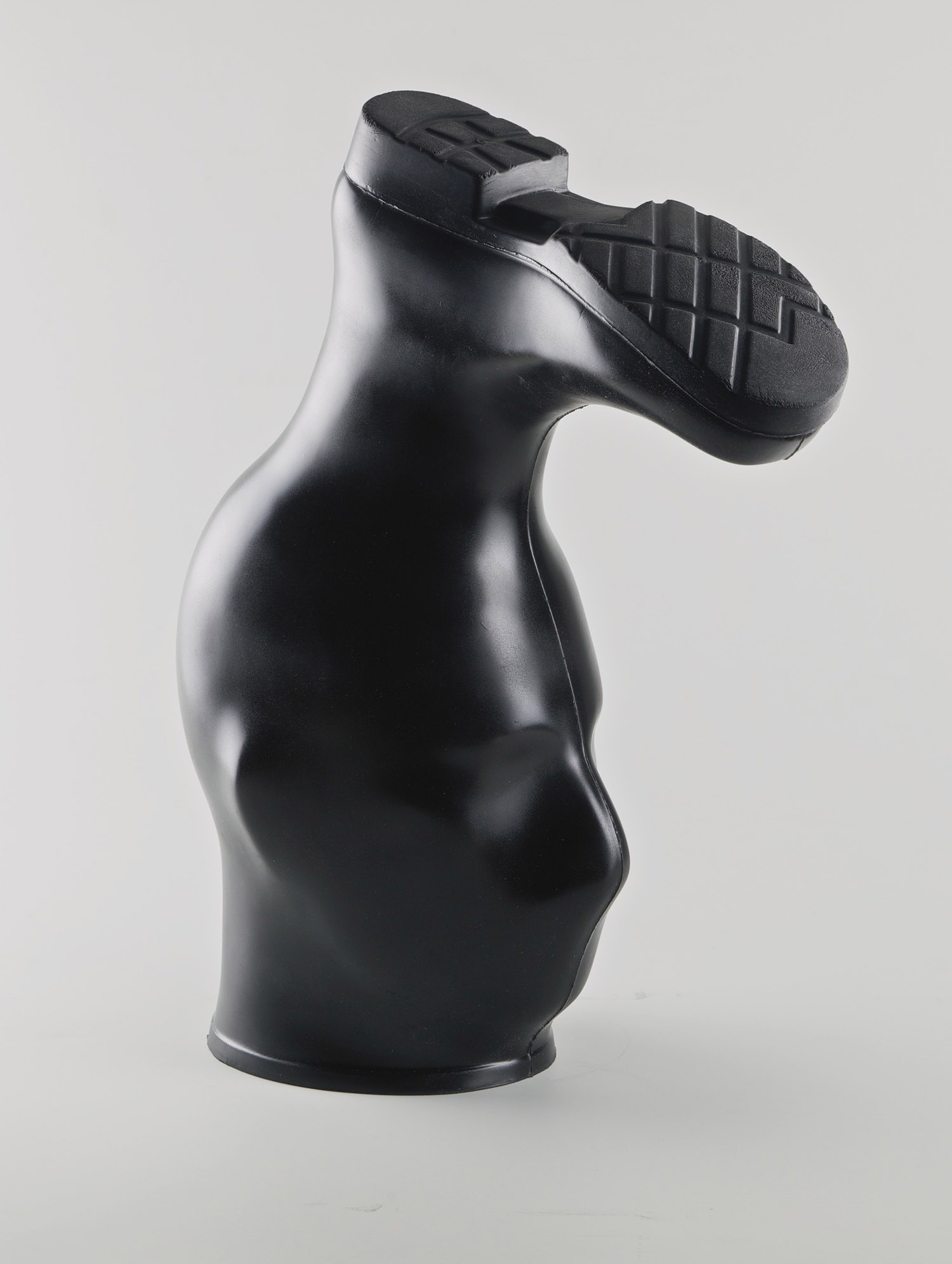
Reflecting on a decades-long affair with the ghostly portraiture that relentlessly crawled out of brash abstraction, Willem de Kooning remarked: “Figures may be in a landscape, or I don’t know where exactly. Not here, not there, but somewhere.”1 Forever limning this elusive figure, de Kooning pushed fleshy, thick and corporeal brushstrokes into otherwise abstract compositions — often adding, almost as afterthought, the lush but rude contours of a pair of wide eyes, lips and breasts. Clement Greenberg called this a homeless representation; de Kooning refused to justify such creeping figuration, even as it forever marred otherwise abstract canvases. Apparent to both was the condition of the dispossessed portrait — the figure with and within, and yet wholly not a part of, the ground from which she emerged.
In 1960, twenty-four-year-old Eva Hesse was keenly attuned to this aporia in de Kooning’s brash impasto. As a painter, she was also fascinated by Gorky’s incisive gestures and Dubuffet’s splayed nudes; by the CoBrA group and Öyvind Fahlström — all who captured her increasing interest in the realm of painting’s concerns.2 Newly graduated from Yale, Hesse had moved to a small studio on Ninth Avenue in New York. There she worked part-time designing jacquard looms at a textile factory (introducing her to a wealth of materials and stitching techniques as a result) and, while in the studio, occupied herself fully with the charge of painting. And, as her diligently diarized reflections suggest, painting was by now a necessity: it allowed her a certain material experimentation, a form of self-possession and psychic probing, while at the same time negotiating a series of historicized formal and ideational concerns. In her diary from the year before, she issued a mobilizing cry for her practice: “Paint yourself out, through and through, it will come by you alone. You must come to terms with your own work not with any other being.”3

From the seventeen or so small canvases Hesse produced from the fall of 1959 to the spring of 1961, nearly all are in fact abstractly figured portraits: ripe and viscous, fleshy but pallid solitary faces, pairs and partners and trinities. As groups or self-portraits, these paintings, representing for decades a kind of ‘repressed’ within the Hesse corpus, invested in a representation of the body through the surplus that cannot be reduced to a proper image: the embodied self and the complex web of interiority through which it situates and represents itself. The intimately scaled oil-on-masonite paintings comprise loose figurations of coupled figures, suspended in (and pushed to the edges of) densely rendered terrain. Several among the series of coupled portraits are exercises in thick, undulating, erotic figuration. Calling to mind de Kooning’s Clam Diggers (1963), these figures emerge out of heavily painted atmosphere as errant and abject extraterrestrials. And, like many of de Kooning’s portraits throughout the ’50s and ’60s, Hesse’s figures threaten, at any moment, to be swallowed up by the broad, abstract swaths of paint around them.4
The paired portraits, suspended in their murky terrain, reveal a visceral pull between connection and detachment. The gangly, full-breasted figures reach for one another, while the thickly gestured planes of color push them forcefully to the edges of the canvas. This longing for proximity — in the paired portraits as the recognition of one interiority confronting another — is acutely felt in six solitary portraits Hesse painted in 1960, each rendered as androgynous and uncanny doppelgangers whose sunken gazes reach out beyond the frame. Each of these works reveals Hesse as feverishly attentive to the affective as well as material terrain of the canvas, while also to the extreme alienation of the self within this ostensible landscape. One particularly sallow portrait gazes dolefully at her viewer, one eyelid pulled down below her cheek. Her bright red lips spotlight her gray face, which is silhouetted against a loose stroke of long black hair. The backdrop, at times excitedly rendered with long, thin scratchings, and dripping onto the figure’s face and hair, threatens to pull the portrait back into the shadows, while her hollowed eyes thrust towards us.
Simultaneously strong-willed and deeply impressionable — particularly by the ‘poetics’ of Carl Andre and close friend Sol LeWitt — Hesse seemed to work in contradiction; and the categorization of Hesse’s work has never been a straightforward enterprise. Hesse focused on these small canvases for only a year before moving fully into the domain of sculptural assemblage, working towards the formal and metaphorical edges of sculpture until her death in 1970. And yet, Hesse always thought herself, like LeWitt, a painter at heart.5 To return to these canvases then — so ruptured from the popular understanding of Hesse’s more famous sculptural project — is to consider Hesse’s oeuvre, marked by deep introspection and penetrating material exploration, as the work of a painter. And yet to reconcile these powerful canvases among her larger oeuvre is, after all, to consider not the either/or of Eva Hesse, but a body of work whose richness lies in its attempt to articulate difference (e.g. between self and object, between drawing and sculpture).

As a critical project, such reconciliation might begin to draw on the exploration of the embodied subject as seen in one of its most developed forms within postwar painting: the work of Viennese painter Maria Lassnig. From its roots in informel, which Lassnig was influential in developing in Austria, to the impasto figures of the ’60s and her own concept of “body-awareness painting,” her work has sought to reposition portraiture as a form of representing a self-perception of the body. For Lassnig, the figure becomes the result of an embodied self — in both its proprioceptive and exteroceptive dimensions — enacting a performative encounter with the canvas, rather than direct depiction. As an object of self-perception, the body gains its form as a figure through the seismographic register of interiority. Relentlessly investigating this figure/body as a representation of the web of sensory experience, Lassnig’s paintings take the unitary identity of the self as perceived by the subject as their abiding focus. Both Hesse and Lassnig, in this sense, direct a gaze towards the viewer with brash theatricality while also suggesting a ‘felt’ space of the self as their subject. The brushstroke becomes the objective correlative of embodied sensation; in Lassnig’s case, the body as not a static, bounded object, but an oozing and disjunctive homunculus, emerging as dismembered and fragmented, its decay increasingly articulated with remarkable candor and pathos.
In what Linda Norden would call “getting to ick” — the exploration of both the self and the absurd — Hesse navigated the terrain of portraiture as such a space of affective materiality. And yet, “painting herself out” also disclosed her incremental progression towards an organic, eccentric abstraction. It was not long after when, in Germany, she plucked up a wire mesh furnace screen and stuck a rope through it.6 Abstraction for Hesse, however, forever necessitated a slippage between isolation and touch. Painting out the figure in a landscape of abstraction, Hesse’s search for a self, “painting herself out,” longed for a self that gazed back. Flesh or phantom, these portraits reveal a space at once intensely interior and removed, personal and intimate. And, for the fleeting period from which these specters emerged, Hesse remained deeply committed to this expression, writing, in July of that year: “My paintings (last 2) look good to me, for how long this sentiment lasts is questionable… They are painterly. They are developed images, they were really built, made, and came into being. Both of them spoke back.”7

